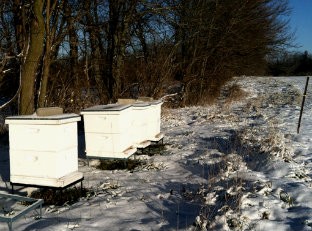The winter life of bees: Social order in the hive

On our small, diverse farms in central Illinois, walking aimlessly is a luxury reserved for the winter months, when the past season’s roller coaster has slowed almost to a stop and the new season’s marathon has yet to begin. At this quiet cusp of the seasons, there is ample time in the short days to hike through woods and over streams, and even more time to contemplate life, forward and back, during the long nights.
On one of January’s crisp, bright mornings, I went for a walk in the sparkling snow. I had no particular purpose in mind but knew, as Frost wrote, “how way leads on to way . . .”
Soon four beehives beckoned, their white paint gleaming almost as bright as the new snow around them. The hives are not ours but belong to a friend of a friend who needed organic farmland, safe from insecticides, on which to house them. We were glad to oblige, for the bees’ sake as well as the beekeeper’s—not to mention our own need for pollinators, without which there would be no cucumbers, beans, squash, tomatoes, okra, melons and much, much more. The deal did not need any sweetening, but still the beekeeper promised us a few half-gallon jugs of honey at season’s end.





